On your holiday to Jaipur do check out the picturesque places to see in and around. Rajasthan’s beautiful Pink City Jaipur, was the stronghold of a clan of rulers whose three hill forts and series of palaces in the city are important attractions. Known as the Pink City because of the colour of the stone used exclusively in the walled city, Jaipur’s bazaars sell embroidered leather shoes, blue pottery, tie and dye scarves and other exotic wares. Most of the places you get to see in Jaipur take you to a royal era. The journey into the past continues in tourist places around Jaipur too.
Find Hotels In Jaipur
The city of Jaipur or the ‘City of Victory‘ was named after Sawai Jai Singh, the Kachhwaha King and the founder the city. The started was built between 1727 AD and 1731 AD. It is the first planned city in India built on the basis of principles of the Shilpa Shastra, the ancient Indian treatise on architecture. The city became famous as the ‘Pink City’ when the entire city was painted with pink color in the honor of the Prince of Wales, who visited Jaipur in 1853 AD. The capital of Rajasthan, Jaipur is steeped in history and culture. Here the past comes alive in magnificent forts and palaces, blushed pink, where once lived the maharajas.
Jaipur has been laid according to the conventional nine-grid pattern that astrologers believe to be lucky, and which has been recommended in the ancient Indian treatise on architecture. Each grid consists of a square, and these have been planned so that, at the heart of the city is the City Palace. Spread around it, in rows, are public buildings, the residences of noblemen, the living and trading quarters of merchants and artisans. Straight, wide roads run through the city, while a high, crenellated wall that forms its defense is pierced with seven gateways that serve as entry points. Today, these walls may be more difficult to spot since the city has grown far beyond its original plan, but they are still there, proof that though Jaipur saw no great siege, it was more than adequately prepared for it.
Jaipur has much to offer visitors — everything from pageants and festivals to extraordinarily clad people, a wealth of handicrafts, a royal legacy of palaces, and sightseeing — that will occupy their time. However, should the visitors simply choose to walk around the streets of the old city instead, they will not regret it. All of Jaipur is an architectural gem, and no scheduled sight seeing can even hope to do justice to this rare city.
Holiday in Jaipur can be exciting with several historic places to visit. The forts, palaces and museums are bound to impress you. City Palace, the former royal residence is the first place to be visited in Jaipur. The palace built incorporating the features of both the Rajput and Mughal style of architecture. The palace houses a museum, which is a treasure trove of the Rajputs glorious past. The exhibits in the museum include various swords, their sheaths, carpets, miniature paintings, rare collection on astronomical works and numerous royal artifacts.
PLACES TO SEE IN JAIPUR
Jaipur forms part of India’s popular Golden Triangle tourist circuit, and lures visitors with its stunning remnants of a bygone era. The royal forts and palaces of Jaipur are the most popular attractions. Most of them boast stunning views and elaborate architecture. Elephant safaris and hot air balloon rides are on offer for the more adventurous visitors. Shopping is fantastic in Jaipur, with everything from jewelry to handicrafts available. Staying in Jaipur is also particularly enjoyable. The city has some incredible heritage hotels that have been converted from old palaces, giving guests a very regal experience.
Jantar Mantar :
This is the largest observatory among those built by the astronomer king Sawai Jai Singh II in various parts of the country. Also called as the “Yantralaya”. Its various instruments (yantras) were used to observe the movements of heavenly bodies as also to measure the local time and predict eclipses.
Hawa Mahal
Jaipur’s signature building, the Hawa Mahal, a multi layered palace, was built by Maharaja Sawai Jai Singh II. The intricate and fascinating facade of the Palace of the Winds is probably Jaipur’s most recognized building. Constructed in 1799, it has five floors that contain rows of small windows and screens. Legend has it that the palace, which overlooks the main street of Jaipur’s lively Old City, was built so that the women of the royal household could watch the street scene below without being observed. The stark maze of pillars and passages inside is nowhere as impressive as the palace’s exterior, but a panoramic view of the city can be had from the top of the building.
Amber Fort
Around half an hour’s drive from the city center, like something out of a fairy tale, Amber Fort is set on a hill top overlooking the Maota Lake. It was the original home of Rajput royalty until Jaipur city was constructed, and contains a number of breathtaking palaces, halls, gardens, and temples. Inside, the elaborate mirror work adds to the grandeur. The fort entrance is reached by walking up the hill, going in a jeep, or taking a lurching elephant ride. Within the Fort lies the famous Jai Mandir (Temple) with its world renowned Sheesh Mahal, a hall full of Mirrors.
Jaigarh Fort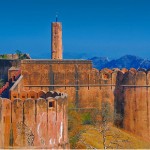
It is one of the few military structures of medieval India preserved almost intact, containing palaces, gardens, open and covered reservoirs, a granary, an armoury, a well-planned cannon foundry, several temples, a tall tower and a giant mounted cannon . Flanked by towering gateways and watchtowers, it contains the world’s largest cannon on wheels. Jaigarh doesn’t have the delicate interiors of Amber Fort, and therefore appears as a real fortress. Climb the Diwa Burj watchtower to get an excellent view over the plains.
Nahargarh Fort
Nahargarh Fort, also known as Tiger Fort, is perched high on the rugged Aravali Hills overlooking Jaipur city. The fort was built 1734 to help defend the city. It found fame in 2006, after many scenes from the movie Rang De Basanti were filmed there. Nahargarh Fort offers spectacular views, which are best seen at sunset. It also makes a great place for a picnic as there’s a cafe on the premises, which serves beer and snacks until 10 p.m. The fort looks particularly attractive at night when it’s lit up.
City Palace
The City Palace is an imposing blend of traditional Rajasthani and Mughal art and architecture.Upon visiting the magnificant City Palace, it’s easy to see that the royal family of Jaipur was one of the richest in India. The huge complex of courtyards, gardens, and buildings blend both Rajasthani and Mughal architecture. The Peacock Gate is exquisite, and contains an alluring display of detailed workmanship featuring bright peacocks. Today, the royal family lives in the graceful Chandra Mahal (Moon Palace) bordering the courtyard. Also inside the City Palace complex is a museum, art gallery, and interesting displays of royal costumes and old Indian weapons.
Diwan-e-Aam / Diwan-e-Khas
Diwan-e-Khas (hall of private audience) is housed between the art gallery (once the diwan-e-aam-hall of public audience) and the armoury. The most attractive feature is the two sterling silver vessels (in the marble-paved gallery) in which Maharaja Madho Singh II, a devout Hindu, took holy Ganga water during a visit to Europe. The two vessels are massive standing 160 cm and have a capacity of 9000 litres each. They are listed in the Guinness book of Records as the biggest silver vessels in the world. From the ceiling of the hall hang a number of chandeliers which are covered with plastic to prevent dust and bird droppings falling on them.
Jal Mahal
Jal Mahal of Jaipur is a pleasure palace built in the 18th century. Situated amidst the picturesque Mansagar Lake, the palace has the Nahargarh hills forming its backdrop. Jaipur Jal Mahal Palace is an architectural beauty and was meant to be used for the royal duck shooting parties. Developed as an enjoyment spot, it is entered through a causeway situated in the middle of Mansagar Lake. Jal Mahal of Jaipur, Rajasthan is a five-story palace, with the first four floors being submerged under water. The Nahargarh Fort situated nearby offers a splendid view of the lake as well as the palace. You can also get magnificent views of the Jal Mahal place of Jaipur from Mansagar Dam on the eastern side of the lake. The Mansagar Lake is also a bird watcher’s paradise as it serves as the home of a variety of local as well as migratory birds. Opposite the palace are the cenotaphs of the royal family.
Fairs & Festivals
Teej (July-August) is probably the best known, and marks the onset of the monsoon. Women in full festive dresses symbolically play on flower-decorated swings.
Gangaur Festival (March-April) is another festival concentrating on women when they pray of Goddess Parvati, and a procession in full regalia is taken out through the city.
Elephant Festival (March) Playing holi on these majestic mammals is a unique sight during the festival.
Getting there
Air : Indian Airlines connect Jaipur with Delhi, Jodhpur, Udaipur, Aurangabad, Bombay, Varanasi, Calcutta, Ahmedabad.
Rail: Jaipur is connected by rail with Delhi, Agra, Ahmedabad, Ajmer, Abu Road (Mount Abu), Udaipur, Bombay and Sawai Madhopur.
Road: Good motorable roads connect Jaipur with Delhi 258 km, Agra 236 km, Bikaner 321 km, Udaipur 405 km, Ajmer 131 km, Jodhpur 316 km, Bharatpur 176 km, Jaisalmer 638 km and Bombay 1202 km
Bus : Regular buses ply from Jaipur to the above places and Alwar, Kota, Sariska, Mathura, Indore, Chittorgarh and Barmer.
By car : This is the most popular way of reaching from Delhi. The journey by car from Delhi to Jaipur takes less than 4hrs. National Highway no. 8 connects Delhi to Jaipur via the industrial township of Gurgaon. The road is excellent.
Where to Stay in Jaipur
Jaipur “The Pink City” has a number of hotels that are well equipped with modern amenities and facilities. You can select an accomodation from Heritage hotels to five star hotes to budget hotels depending upon your pocket. Jaipur has a number of heritage hotels, which have been converted into hotels from the erstwhile palaces and havelis of Jaipur royalty.
Shopping in Jaipur
A major gem and jewellery centre, Jaipur is famous for Kundan work (enamel work on gold). Also there are woollen carpets, cotton rugs, marble statuary, enamelled wares, brass ware, hand-block printed Sanganeri and Bagru Cotton fabrics, exotic blue pottery made from crushed quartz, leather footwear and more
General Information about Jaipur
State: Rajasthan
STD Code: 0141
Area : 64.75 sq. km. Jaipur City
Altitude : 431 metres
Population : 1.9 million
Climate : Summer 45°C (MAX)-25.8°C (MIN)
Winter 22°C (MAX)- 8.3°C (MIN)
Rainfall : 64 centimeters
Best Season : September – March
Clothing : Summer – Light tropical
Winter – Light Woollen
Language : Rajasthani, Hindi, English
Image Gallery Of Jaipur
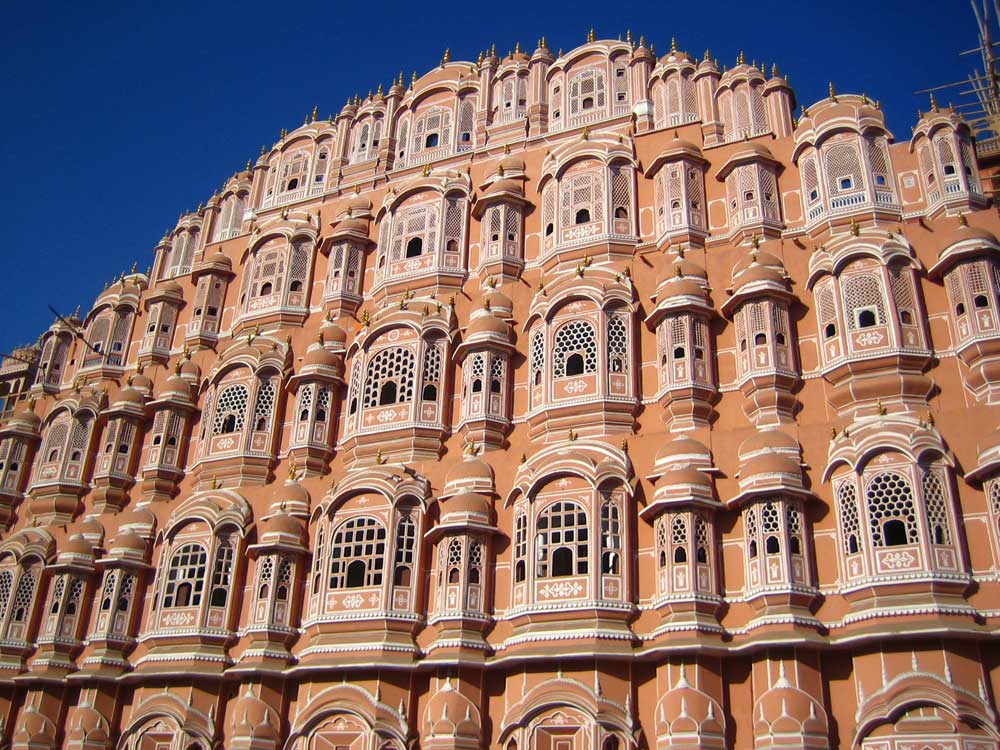
Submit your review | |
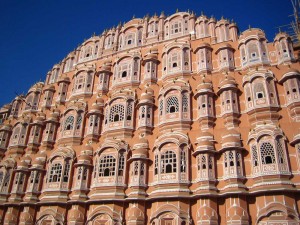
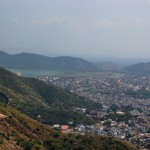
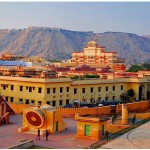
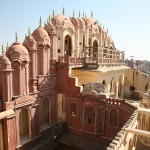
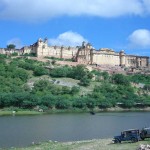
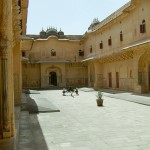
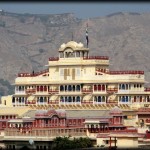
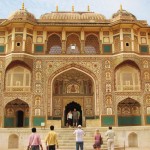
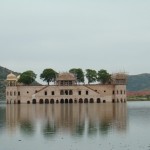

























this one is very good, keep it up . the photos r wonderful.